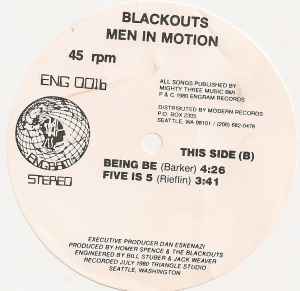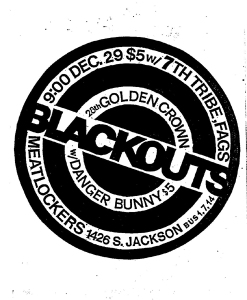While putting my book together, I had to make some calls about which bands to write about, and how much print to give each one. Since Seattle had so many great bands over the period I cover (1975 to 1990), that task proved a challenge. Once I completed my initial selection process, I had to cut a bunch more during editing. Fortunately, this blog allows me to write about those bands that didn’t make the cuts.
That leaves us with the Living, who had a brief life…1981 to 1982 (maybe ’83), but had an incredible amount of talent and following. The Living featured an extremely talented, melodic singer in John Conte, and bassist in Todd Fleischman. Initially, the guitar player and drummer rotated instruments: Duff McKagan (later in 10 Minute Warning and Guns N Roses), and Chris Utting (aka Chris Crass). “John was a good singer,” says Todd, “probably too good of one for punk rock. He knew how to sing from the diaphragm.”
Duff, who would go on to play bass for GNR, also had incredible talent. “Duff is like Brian Jones,” says John. “You can stick him in a room with an instrument he’s never played and within thirty minutes, he’ll have learned the instrument.”
Desiring a full-time drummer, the band jettisoned Utting and put an ad in the Rocket, Seattle’s monthly music magazine. “I answered an ad in…the Rocket,” says virtuoso percussionist Greg Gilmore, “…some [band’s] looking for a drummer.”
Gilmore immediately upgraded the band. “We became…tighter,” says Todd.
“Just [an] amazing drummer,” he continues. “Boy, that guy could play [in] any band and be amazing.”
The Living gigged around town, and began to gain quite a following. They also quickly learned about the sleazier side of the club scene. Fortunately, all of the band members save Conte stood over six feet in height, and were not afraid to confront some of the seamier players. “We did a gig one night down in Pioneer Square,” says John. “This place was notorious for—you set up your equipment, and you turn your back and it gets stolen. And it happened weekend after weekend after weekend.
“And I am totally fearful that this is gonna happen to us,” he continues. “And I kept saying [to the other band members], ‘We can’t leave the club to go out and have a smoke or anything. We cannot leave the club.’
“And sure enough, all the guys wanna go outside and go eat or do something for a while until the show’s supposed to start at 9. And we get back there a half hour before, and all of our instruments are gone. We go to one person in the club. And we told him that if the equipment isn’t back up on stage in 30 minutes, then we are going to basically break him in half. And Todd’s family is there—his brothers. And…the equipment magically reappears.
“And no one ever messed with us—everywhere we went—no one ever messed with our band.”
The band members’ tough reputation quickly permeated the town. “I have my one singular connective experience with Todd Fleischman,” remembers Stone Gossard, later with Pearl Jam. “…I was completely out of my mind drunk and probably on some kind of valium, or something, and was [obnoxious] at some party, and Todd Fleischman finally just said, ‘Oh, shut up,’ and fuckin’ slugged me—knocked me out. Fantastic.”
In the summer of 1982, the Living shared a bill with the Fastbacks at Larry Reid’s Rosco Louie gallery. “That was a great show,” Todd remembers. “Just really killer. We played a version of ‘Ballroom Blitz’ and it just knocked the place down.”
“The Living opened with Sweet’s ‘Ballroom Blitz,’ one of the coolest songs ever,” adds Dave Dederer, (later with the Presidents) in a piece he wrote for the Seattle Times, “and they even did the little intro rap (‘Ready, Todd; alright, Duff; OK, fellas, let’s go!’).
“After the show,” Dave continues, “[my friend] Ben and I and a few others were hanging out in front of the gallery, winding down in a sort of post-orgasmic daze. A large group of frat-boy types…sniffed us out and started advancing down the street, taunting us with crude locker-room epithets. I was scared. I mean, there were 20 of these huge drunk guys, and our ragtag little group would be no match. I was looking to run down the alley.
“And then Todd Fleischman just snapped….he took off up the street with his shirt off, screaming at the top of his lungs. He didn’t utter a word, just roared like a lion.”
“I just went crazy then,” says Todd. “I was just kind of a wild kinda guy. I wasn’t gonna let my friends get pushed around by frat boys. I kinda went crazy. And then they ran away [laughs].”
“Score one for the good guys,” says Dave.
As far as the band’s sound went, it’s hard to get a definitive answer. “It was pretty straightforward power pop,” says Greg, who has never been a big punk rock fan. “We had a guy who could actually sing.
“It was,” Greg continues, “somewhat similar maybe to [the Southern California surf/punk band] Agent Orange.”
“I was thinking more of…Generation X [Billy Idol’s band before his solo career],” Todd counters. “I don’t know if we were really totally like the Agent Orange.
“I don’t even consider us,” Todd adds, “…that much punk rock. We played fast and stuff, and kinda semi-political.
“I think John was more like Roger Daltrey. ’Cause he liked to swing that microphone and sometimes it’d smack onto people’s heads.”
Regardless, the Living’s talent and regular gigs got the band noticed by a person who would become a pivotal figure in the scene. “We played around for awhile,” says Greg. “People liked us. One day at rehearsal, some guy approached us, said he had this idea to make records. And he was kinda starting this label thing. And he just thought that there really was a sound developing…in Seattle, and he thought he could do something with that. And we didn’t really pay that much attention to him. We thought he was a little bit weird.”
And who would that be?
“That was Bruce Pavitt [who later started Sub Pop Records],” Greg answers. “…We blew Bruce off. And there’s a lesson for ya.”
The Living’s talent, egos, and drugs eventually doomed the band’s long-term career prospects. “One thing that those guys don’t know,” says John, “is once the band ended, LA was calling. They wanted us. I had three different offers for the Living from LA. But I was a person who always was honest. And each time I talked to them, it went ‘click’ when I told ’em that the group didn’t exist anymore. And they’d say, ‘Well can’t you get it back together?’ And I’d say, ‘No. I don’t think it’s ever gonna get back together.’ And they’d say, ‘Well, okay…if it ever gets back together…we’re gonna be interested.’”
Following the band’s demise, John dropped out of the music scene, Todd joined the hardcore Silly Killers, and Greg and Duff headed down to LA*. Duff answered an ad in the local paper from a guitar player named Slash. A bunch of the musicians got together to jam. After a few months, Greg had enough of the excess drinking and partying and headed back to Seattle, while Duff stayed…and that became Guns N Roses. “I see and hear the Living in Duff’s band,” says John, “with his heavy metal band, with Axl and Slash. I can hear it, definitely. I even think that ‘[Paradise] City’—I don’t remember exactly, but I think he has a lot to do with that song, ’cause he used to talk about Madison Park, where all the girls are fresh and pretty.”
“And every time like I hear the first album from Guns N Roses,” Todd adds, “I go, ‘Hey, that sounds a lot like us!’
“If we coulda hung on just a few more years,” Todd continues, “we coulda been where the Pearl Jams, and Nirvanas [ended up.] We coulda been there. Mudhoney and all those guys—we woulda smoked ’em.
“We were a band that coulda been.”
* – note: Duff and Greg played in 10 Minute Warning before heading to LA.







